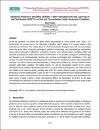Statistical Analysis of the Effect of Water Table Fluctuation and Soil Layering on the Distribution of BTEX on Soil and Groundwater Under Anaerobic Condition
Abstract
Crude oil, gasoline, and diesel fuel spills pollute groundwater in many coastal areas. BTEX is a hydrocarbon of concern due to its high-water solubility, which allows it to spread widely in the subsurface environment. The mobile phase of LNAPLs percolates through porous soil and accumulates above the water table. Subsurface geological, pollutant morphology, and hydrogeologic site features make natural attenuation difficult to understand. Texture and vertical spatial variability affect soil hydraulic properties and water and contaminant distribution in soil profiles. Changes in rainfall strength and frequency and increased water demand may increase groundwater level oscillations in the next century. Five sets of columns, including one soil column and one equilibrium column, were operated for 150 days. One of the columns was operated under a steady state condition (S), and four columns under transient water table condition. The stable column (S), and the Fluctuating column 1 (F1) contain homogenized soil, while the fluctuating columns 2, 3, and 4 contains heterogenous soil. ORP values at the middle of the columns varied cyclically with WTF. EC values affected greatly by fluctuation and temperature and the statistical test p-value 3.119e-10 < 0.05 implying that there are statistical differences between EC values of these columns. On the other hand, pH for the five columns were fluctuated in the same range (P-value 0.3694 > 0.05). Soil layering affects the attenuation of BTEX, as the peak concentrations for benzene occurred at second imbibition cycle for the homogeneous soil, while for the heterogeneous soil occurred between second and fourth imbibition cycles.
Collections
- Civil and Environmental Engineering [892 items ]
- Theme 4: Water, Environment, and Climate Change [40 items ]


